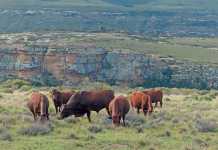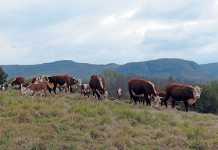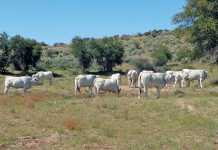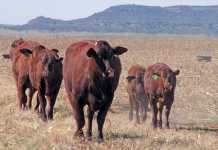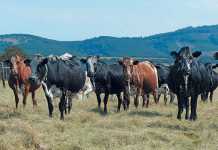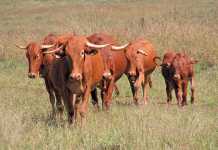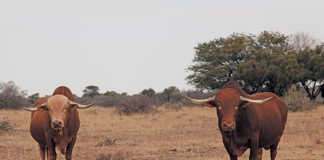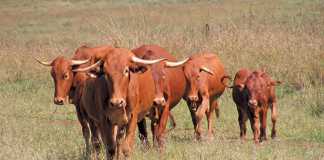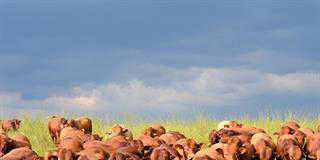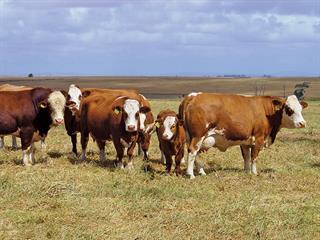
Feeding beef cows the correct diet is imperative for the optimal performance of a farmer’s herd. As beef cows have different nutritional requirements at different stages of their production cycles, beef farmers must adapt feeding processes accordingly.
Mismatching nutrient provision with these requirements can detrimentally affect their reproduction and the profitability of the entire enterprise.
With drought conditions affecting the quality of forage on many farms, farmers should take extra care to meet their cows’ nutritional needs.
The different nutritional requirements of beef cows
Lactating beef cows have the greatest nutritional needs, while requirements during advanced pregnancy are also significant (see Table 1).
When these requirements are not met, reproductive performance will be negatively affected as there are several mechanisms that play a role when a cow does not conceive.
On the other hand, when these requirements are exceeded, a cow will, in most cases, increase her body reserves (fat and muscle) to be utilised at a later stage.
READ: Good FCRs in beef cattle
A cattleman must understand his/her beef cows’ basic maintenance nutritional requirements, as well as those during lactation and pregnancy.
Table 1 shows the crude protein, metabolisable energy, and phosphorus requirements during the typical production cycle of a cow that calves annually.

PEM in beef cows
Protein-Energy Malnutrition (PEM) syndrome is well documented among cattle in dry subtropical areas, where it typically occurs in pregnant cows on the veld during the late dormant season.
This is partly due to low forage quality, but mostly to a shortage of forage, particularly when poor planning at the start of the dormant season results in overstocking.
Without sufficient supplementation, excessive pressure is placed on available forage. Under these conditions, a cow cannot ingest sufficient protein and energy to meet her maintenance requirements.
She will utilise her body reserves to a point where severe muscle mass loss results in weakness and the inability to stand. When a non-pregnant female is exposed to such conditions, reduced thyroid hormone levels will reduce her basal metabolic rate.
If the cow is in advanced pregnancy, the foetus’ increased nutrient demand and the hormones maintaining the pregnancy will help to avoid this process. The cow will deteriorate and even die in extreme cases.
PEM’s effect on reproduction
One of the most important physiological changes in a cow suffering from PEM is a low level of albumin, the basic protein that nourishes many metabolic pathways in the blood.
A recent study at the Department of Production Animal Studies (DPAS ) at the University of Pretoria, shows that a blood albumin level below 36g/l indicated mild undernourishment, and one below 31,5g/l severe undernourishment.
A more recent study at the University of Pretoria’s in vitro fertilisation (IVF) laboratory highlighted the importance of a high level of blood albumin, as it assists the oocytes’ (eggs) ability to develop into embryos.
Oocytes retrieved from Hereford and Nguni cows with mildly lowered blood albumin levels were observed to be less likely to cleave and develop into embryos in the laboratory than oocytes from cows with adequate blood albumin levels.
Overcoming PEM with non-protein nitrogen
Providing non-protein nitrogen (NPN) in the diet is a recognised way of overcoming a protein deficiency during the dormant season when forage has very low protein levels.
NPN is mostly supplied in the form of feed-grade urea, a cost-effective nitrogen source for ruminants, which ruminants convert to useable protein in their rumens.
This conversion process requires energy, and feeding excessive urea or insufficient energy may increase the level of urea absorbed into the blood.
High blood urea levels
For years, high blood urea levels have been associated with poor reproduction in cows, particularly dairy cows. Urea levels in milk are routinely measured to monitor the protein and energy balance in dairy cow rations.
READ: Feeding dairy cows – Part 1
Another recent study at DPAS confirmed the relationship between an elevated blood urea level and poor reproductive performance in beef heifers.
In this study, a relatively high blood urea level was associated with a reduced pregnancy rate during the following breeding season.
This was only the case in herds supplemented to the extent that overall crude protein intake was above 12% until just before the breeding season.
In herds where this intake was above 14%, heifers with high blood urea levels were less likely to conceive. Those that did conceive only did so late in the season.
In herds where elevated blood urea levels affected fertility, farmers underestimated the forage’s protein contribution and over-supplied heifers with non-protein nitrogen.
The more-is-better approach
This more-is-better approach to protein supplementation is clearly not beneficial.
Data from the Nguni and Hereford cows’ study confirmed that a blood urea level above 20g/dl affected the quality of the oocytes negatively, when assessed microscopically immediately after harvesting them from the cows.
The high blood urea level reduced the percentage of live oocytes, as well as the percentage of live oocytes with cumulus cell coverings (Table 3). (The cumulus consists of a number of cells around the oocyte that provide nutrients and hormones for its survival and development.)
The negative effect of blood urea on oocyte quality apparently starts very soon after a high blood urea level is reached, but the association with poor reproductive performance can persist for a few weeks.
Energy
Highly fermentable carbohydrate energy sources, such as sugars, are essential for providing rumen microbes with energy to utilise non-protein nitrogen sources such as urea.
The oestrus cycle in a cow experiencing low energy and protein nutrition is likely to be halted completely. This condition, called nutritional anoestrus, is caused by down-regulation of the hormonal pathways maintaining the oestrus cycle.
It is probably an evolutionary defence mechanism designed to prevent the cow from conceiving during times of severe feed scarcity to preserve her own life.
A fact that is more relevant to well-managed, high-producing beef cows is that fat reserves that break down faster than usual result in a temporary low energy level. This increases the level of ketone bodies in the blood. Ketone bodies are fat metabolites that have a negative effect on fertility by decreasing the viability of the oocytes.
The research demonstrated the negative effect of an elevated ketone body level on the ability of oocytes to cleave and develop into embryos in the Nguni and Hereford cows.
This was despite the cows not being pregnant or lactating at the time and their energy requirements therefore being used only for maintenance. These effects occurred at even lower increases in ketone levels than can be expected in a lactating cow.
Phosphorous lick during lactation
A cow’s phosphorus requirements are high during early lactation, which coincides with the start of the breeding season in high-producing beef cows.
As practically all of Southern Africa is phosphorus-deficient, a phosphorus lick supplement during early lactation is the management tool with the most significant influence on fertility.
Nutrients from the veld
On typical SA sourveld, the crude protein level in the winter grass can be as low as 4%, while early-season grass grows rapidly and the crude protein level can be as high as 9%. Dry matter intake during the growing season is also high due to the palatability of the grass, resulting in a high protein and energy intake
Later in the rainy season, the grass lignifies and its protein level drops. During the dormant season, a cow’s dry matter intake can decrease significantly due to the grass’ poor palatability and low protein level. This results in an inadequate protein supply to the rumen microbes and a resultant decrease in cellulose fermentation.
READ: Managing feed and breeding in replacement females
Fermentation in the rumen, and therefore also dry matter intake, can be improved by supplementing protein during this time. During the dormant season’s last phase, just before the rain starts, dry matter intake from grazing decreases further as the more palatable grass species have been selectively grazed down (Figure 1).
Matching forage resources with the production cycles of beef cows
Knowing the forage’s nutrient composition enables one to calculate the nutrients a cow gets from the grazing, as a percentage of her total requirement. This will depend on the time of the year she calves, as the nutrient availability varies considerably within the calendar year. Table 5 indicates figures for four different calving times.
The table shows that spring calving matches the nutritional needs of the cow on natural grazing the best. For spring calving, protein supplementation is only needed during the dormant season, particularly during the latter part.
Cows permanently running with the bull tend to fall into the spring calving category after a few seasons, due to nutritional deficiencies at certain times of the year that prevent them from completing their normal production cycles. This is also Southern Africa’s most commonly used calving season in summer rainfall areas.
Autumn calving is the summer rainfall regions’ second-most common practice but, as Table 5 shows, it is a compromise. Farmers use it when stover from harvested maize lands is reliably available in winter. A benefit of this is that weaners can be marketed at a time when the weaner price tends to be high.
Table 5 shows how, in an autumn calving season on veld grazing, the nutritional requirements of the cows cannot be met for six months of the year but are significantly exceeded for two months of the year. This results in the cows losing body condition (fat and muscle) during the calving and breeding seasons, then regaining it again towards the end of lactation, particularly after weaning.
Cows in this system tend to calve in a good body condition, but the effects of protein and energy deficiency will impair oocyte quality due to low albumin and high ketone levels. The system can therefore be costly, but this really only happens when cows that failed to conceive in the summer breeding season are put to the bull in winter. Farmers should resist this temptation.
Adapted from a paper by Dr Dietmar Holm presented at the Aldam Stockman School held at Aldam Estate, Ventersburg in the Free State last month. Email [email protected] for more information.
This article was originally published in the 27 November 2015 issue of Farmers Weekly.

